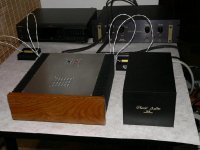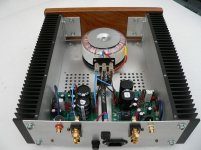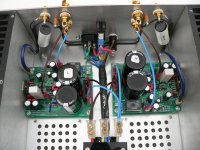Thanks for your prompt replies.
But now I am even in a worst situation than before – I know that something is wrong with my amps and I have no idea what that could be. And I want to find out! What puzzles me most of all – what currents can generate the heat given that all DC voltages are correct, I did not found any oscillations on any pins of the LM318 (and I looked closely!), its load is 47K+22pF? Thermal resistance junction to ambient for HO-8 package is 160C/W, while for dual-in-line package it is 100C/W. Can this be the reason for my problems?
But now I am even in a worst situation than before – I know that something is wrong with my amps and I have no idea what that could be. And I want to find out! What puzzles me most of all – what currents can generate the heat given that all DC voltages are correct, I did not found any oscillations on any pins of the LM318 (and I looked closely!), its load is 47K+22pF? Thermal resistance junction to ambient for HO-8 package is 160C/W, while for dual-in-line package it is 100C/W. Can this be the reason for my problems?
Hi lumumba_p,
Since all three monoblocks have the same problem and you are obviously a careful and experienced builder, it seems to point to the LM 318 package you are using as the culprit. Might be time to revert to the National dip package. I'm no expert, but it may be a good place to start.
My Twisted Pear Rev C Amp has had 13 hours of a 36 hour burn-in with an 8 ohm dummy load with 10W average music signal so far, and all the voltages look ok.
The LM 318 in both monos are only warm.
Hope you solve your problem soon so you can get some sleep.
Regards,
Audie.
Since all three monoblocks have the same problem and you are obviously a careful and experienced builder, it seems to point to the LM 318 package you are using as the culprit. Might be time to revert to the National dip package. I'm no expert, but it may be a good place to start.
My Twisted Pear Rev C Amp has had 13 hours of a 36 hour burn-in with an 8 ohm dummy load with 10W average music signal so far, and all the voltages look ok.
The LM 318 in both monos are only warm.
Hope you solve your problem soon so you can get some sleep.
Regards,
Audie.
lumumba,
My LM318 was part of the Twisted Pear kit.
Would be nice to know an Aussie supplier though.
Nordic's suggestion would not be the best choice, since the Op-Amp he points to is by Texas Instruments and is an LM318P.
You should use a National Semiconductor LM318N as specified for Mauros My Reference. You don't need more trouble than you already have.
You could try Semico Components Pty Ltd at:
http://www.semico.com.au/
They have National Semi. LM318N DIL op amps available. Send a query from their site.
Do not know if they deal with individuals though.
Audie.
My LM318 was part of the Twisted Pear kit.
Would be nice to know an Aussie supplier though.
Nordic's suggestion would not be the best choice, since the Op-Amp he points to is by Texas Instruments and is an LM318P.
You should use a National Semiconductor LM318N as specified for Mauros My Reference. You don't need more trouble than you already have.
You could try Semico Components Pty Ltd at:
http://www.semico.com.au/
They have National Semi. LM318N DIL op amps available. Send a query from their site.
Do not know if they deal with individuals though.
Audie.
billabong said:lumumba,
My LM318 was part of the Twisted Pear kit.
Would be nice to know an Aussie supplier though.
Nordic's suggestion would not be the best choice, since the Op-Amp he points to is by Texas Instruments and is an LM318P.
You should use a National Semiconductor LM318N as specified for Mauros My Reference. You don't need more trouble than you already have.
You could try Semico Components Pty Ltd at:
http://www.semico.com.au/
They have National Semi. LM318N DIL op amps available. Send a query from their site.
Do not know if they deal with individuals though.
Audie.
Hi
I had no problems useing the Texas Instruments LM318P in both rev_a, rev_c
lumumba i think that you should check again and again your pcb, all parts be patience and the problem will be solved.
Good luck!
Hi,
Finally have my TP Ref C Amp built and am in tte middle of burning it in.
With the variac set to 238v rms, the T/F sec.volts are 26v. The DC rails are +/- 35V.
The DC offsett is -1mv, with or without the preamp connected.
With an average 10W music signal at the 8 ohm dummy loads, the DC offsett mainly stays at a few -mv ,with momentary peaks to around -10mv.
I have upgraded a few components of the Twisted Pear kit:
Bridge Rectifier -- General Semiconductor GSIB2540 (25A,400V)
C9 --- Rubycon ZA 35V, 220mF
C21 --- Vishay Roderstein MKP 0.1mF, 160V
C13 --- Rel-Cap Multicap Film & Foil Polystryrene 1mF, 100V
All going well I should connect speakers tomorrow.
I'll attach some photos
Audie.
Finally have my TP Ref C Amp built and am in tte middle of burning it in.
With the variac set to 238v rms, the T/F sec.volts are 26v. The DC rails are +/- 35V.
The DC offsett is -1mv, with or without the preamp connected.
With an average 10W music signal at the 8 ohm dummy loads, the DC offsett mainly stays at a few -mv ,with momentary peaks to around -10mv.
I have upgraded a few components of the Twisted Pear kit:
Bridge Rectifier -- General Semiconductor GSIB2540 (25A,400V)
C9 --- Rubycon ZA 35V, 220mF
C21 --- Vishay Roderstein MKP 0.1mF, 160V
C13 --- Rel-Cap Multicap Film & Foil Polystryrene 1mF, 100V
All going well I should connect speakers tomorrow.
I'll attach some photos
Audie.
Attachments
Russ,
Thanks for the kind words.
I wanted laser cut anodised panels, but the cost was excessive.
Hand finished plain aluminium still looks acceptable though.
I know I am going to enjoy Mauro's "My Reference".
Mauro's meticulous design work and your execution of a great kit, ensures it.
Thanks,
Audie.
Thanks for the kind words.
I wanted laser cut anodised panels, but the cost was excessive.
Hand finished plain aluminium still looks acceptable though.
I know I am going to enjoy Mauro's "My Reference".
Mauro's meticulous design work and your execution of a great kit, ensures it.
Thanks,
Audie.
I slipped up-again. I have both Brian and Russ to thank for providing the kits. Thanks guys.
I do wonder why anyone would want to make their own boards and source the components, when such a fine economical kits are available. The rev c double sides boards are available separately as well. A board you make yourself will likely be inferior.
Audie.
I do wonder why anyone would want to make their own boards and source the components, when such a fine economical kits are available. The rev c double sides boards are available separately as well. A board you make yourself will likely be inferior.
Audie.
billabong said:I wanted laser cut anodised panels, but the cost was excessive.
Hand finished plain aluminium still looks acceptable though.
Great implementation billabong!
I did my RevA with lasercut panels, and it turned out pretty well, but I like yours better
What timber is the front panel?
Thanks Billabong, Nordic, Enter and Brian for your advice. It looks like FuturLec is the only option available. I bought 10pcs LM3886 from them a while ago. It took about 4 weeks and the actual cost was much higher than expected due to postage, taxes, etc.
As I have mentioned I am building 3-way active loudspeakers and want to build in my amps. LM3886 looks very attractive from this perspective and Mauro’s current pump has some definite advantages when used in such configuration. Space requirements of my system, price of the kit and the fact that I cant use 35mm diameter caps forced me to re-design the PCB. And why it should be inferior?
Great work on the case, Billabong. Did you consider adding surge-RF filters to the mains? You can get plenty of them on the streets these days (from PC power supplies).
billabong said:I do wonder why anyone would want to make their own boards and source the components, when such a fine economical kits are available. The rev c double sides boards are available separately as well. A board you make yourself will likely be inferior.
Audie.
As I have mentioned I am building 3-way active loudspeakers and want to build in my amps. LM3886 looks very attractive from this perspective and Mauro’s current pump has some definite advantages when used in such configuration. Space requirements of my system, price of the kit and the fact that I cant use 35mm diameter caps forced me to re-design the PCB. And why it should be inferior?
Great work on the case, Billabong. Did you consider adding surge-RF filters to the mains? You can get plenty of them on the streets these days (from PC power supplies).
Thanks maf_au,
I liked the idea of heatsinks for the side panels as it saved me work and provides a mounting for the remaining panels.
It looks good as well. No problem identifying it as anything other than a power amplifier.
The front panel was cut from my wife's 22mm thick dark Teak cutting board that she had rarely used.
If I should ever build the Kookaburra Preamp and the subwoofer active crossover, there is some left over for those too.
Regards,
Audie.
I liked the idea of heatsinks for the side panels as it saved me work and provides a mounting for the remaining panels.
It looks good as well. No problem identifying it as anything other than a power amplifier.
The front panel was cut from my wife's 22mm thick dark Teak cutting board that she had rarely used.
If I should ever build the Kookaburra Preamp and the subwoofer active crossover, there is some left over for those too.
Regards,
Audie.
Hi lumumba,
My remark re. rev c boards was not about you or anyone in particular. Sorry if I gave that impression.
The reason I qualified my remark with "likely" be inferior, was to allow for those people capable of making a PCB as good as a professionally manufactured one, even a double-sided board such as the rev c.
I think that for the majority of us though, our PCB efforts will be less than perfect.
You could not use the rev c boards for good reason, so naturally had to use your own resources.
Re. power line filtering; I made up quite a few outboard ones from Electronics Australia kits many years ago and always use them.
Pity FuturLec don't ship by US post "small packet", since the postage is cheap and they arrive without the 10% GST charge.
Twisted Pear kits ship that way.
Good luck with your active speakers.
Audie.
My remark re. rev c boards was not about you or anyone in particular. Sorry if I gave that impression.
The reason I qualified my remark with "likely" be inferior, was to allow for those people capable of making a PCB as good as a professionally manufactured one, even a double-sided board such as the rev c.
I think that for the majority of us though, our PCB efforts will be less than perfect.
You could not use the rev c boards for good reason, so naturally had to use your own resources.
Re. power line filtering; I made up quite a few outboard ones from Electronics Australia kits many years ago and always use them.
Pity FuturLec don't ship by US post "small packet", since the postage is cheap and they arrive without the 10% GST charge.
Twisted Pear kits ship that way.
Good luck with your active speakers.
Audie.
- Home
- Amplifiers
- Chip Amps
- My "audiophile" LM3886 approach



